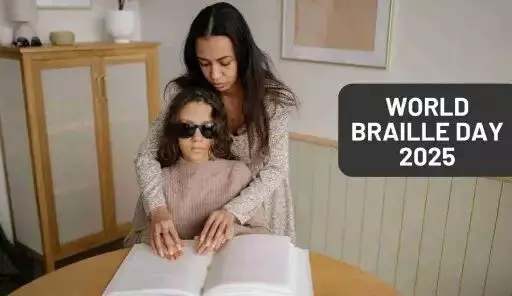Live
- District Collector Inspects Progress of Double Bedroom Housing Projects.
- Paris Fashion Week: A Global Canvas for Indian-International Artistic Brilliance
- "Revanth Reddy Betrays Farmers with Broken Promises, Say BRS Leaders"
- Samagra Shiksha Employees' Indefinite Strike Enters 28th Day with Unique Protests.
- Aiza Congress Leaders Extend New Year Greetings to Dr. SA Sampath Kumar.
- "Jogulamba Gadwal Police Enforce Strict Ban on Chinese Manja Ahead of Sankranti".
- Namo Bharat RRTS: Fares, Route Map, and Travel Features Explained
- Madire Narsing Rao Named Telangana President of Samajwadi Party SC/ST Cell
- "S. Ramachandra Reddy Attends Aija Premier League (IPL-9) Day 4 as Chief Guest, Lauds Youth for Sporting Excellence".
- Nishikori moved up 32 places to return to Top-100 in ATP Rankings
Just In
Empower the Visually Impaired this World Braille Day 2025


Empower the Visually Impaired this World Braille Day 2025
Read to know the story of Louis Braille, the man who invented the Braille system. Learn how braille education is improving worldwide, making a safer space for the visually impaired community.
People around the world come together on January 4th every year to observe World Braille Day. This day honours the visually impaired community and the revolutionary Braille system developed by Louis Braille. It raises awareness about the importance of Braille literacy and also highlights the importance of accessibility, inclusion, and empowerment.
The Man Behind the Braille System
Louis Braille who was born on January 4, 1809, in France, lost his sight at a young age due to a tragic accident. But this disability did not stop him. Determined not to let his disability limit him, he developed the Braille system when he was just 15 years old. This tactile code uses raised dots arranged in patterns to represent letters, numbers, and punctuation. Over time, Braille became a universal tool, empowering visually impaired individuals to access education, communicate, and enjoy literature.
The Importance of Braille Literacy
In today’s world the visually impaired community tries their best to prove that disability is not a limitation and that they can achieve great heights with their will power. With adaptive tools and education, they achieve incredible feats in various fields.
Braille literacy plays a crucial role in enabling visually impaired individuals to achieve independence and equality. It allows them to read books, write, and access information, much like sighted individuals do. Despite the digital age, Braille remains irreplaceable in many aspects of life, from labelling everyday items to navigating public spaces.
How Braille Education is Improving Worldwide
Braille education helps visually impaired children and even adults to increase their literacy and decrease their dependency on other people. Learning Braille from an early age can significantly enhance a visually impaired person’s quality of life. Braille education equips students with essential skills, enabling them to excel academically and professionally. Schools and organizations worldwide offer specialized programs to teach Braille, ensuring that visually impaired children and adults can thrive in all areas of life.
Braille Education has improved a lot in the past few years with the advancement in technology and increased accessibility, empowering visually impaired individuals worldwide. Innovations like refreshable braille displays and audio-braille integrations are making learning more interactive and inclusive. Enhanced teacher training and global initiatives ensure wider adoption, thus decreasing the dependence on other people and opening up opportunities in education and employment.
Empowering the Visually Impaired by incorporating Braille in Public Spaces.
Using Braille in public spaces is a simple yet powerful way to empower the visually impaired community. It makes the public places more accessible and friendly for them. From elevator buttons to ATM machines and tactile maps, Braille signage helps visually impaired individuals navigate their surroundings safely and independently.
Some benefits of braille signage are:
- Independent in finding a way – Visually impaired people can find their way in unfamiliar environments without relying on anyone using braille signage. This boosts their confidence.
- Accessible navigation – Finding entrance, exits, stairs etc can be challenging for visually impaired people. Braille signs can help them by indicating the floor number, gender of the washroom etc.
- Increased Safety – Clear instructions provided by braille signs helps visually impaired people to find emergency exits and evacuation routes. This helps them locate stairs or any other potential hazards.
- Inclusive restroom facility – Many public spaces have included braille signs to help visually impaired people feel comfortable and use public restrooms with any hinderance.
Braille Innovation: The Future of Accessibility
As technology continues to evolve, so does Braille innovation. Developers are working on advanced tools like smart glasses that convert text into Braille, portable Braille printers, and AI-driven solutions to enhance accessibility. These breakthroughs promise a future where the visually impaired can enjoy unprecedented levels of independence and integration.
On this World Braille Day, let’s honour the legacy of Louis Braille by committing to a world where everyone has equal opportunities, regardless of their abilities. Through education, innovation, and advocacy, we can ensure that the visually impaired community continues to thrive and contribute to society.

© 2024 Hyderabad Media House Limited/The Hans India. All rights reserved. Powered by hocalwire.com






